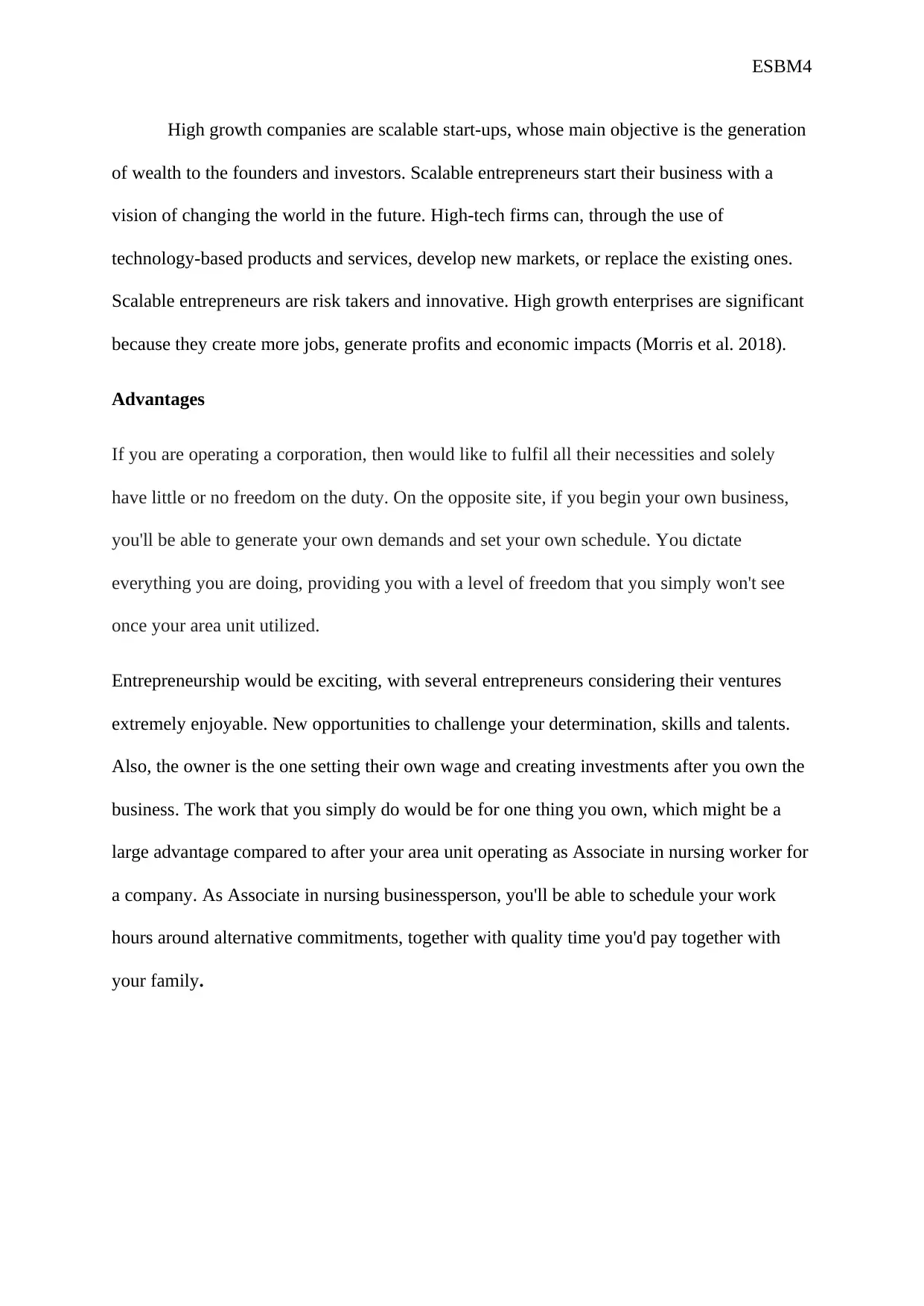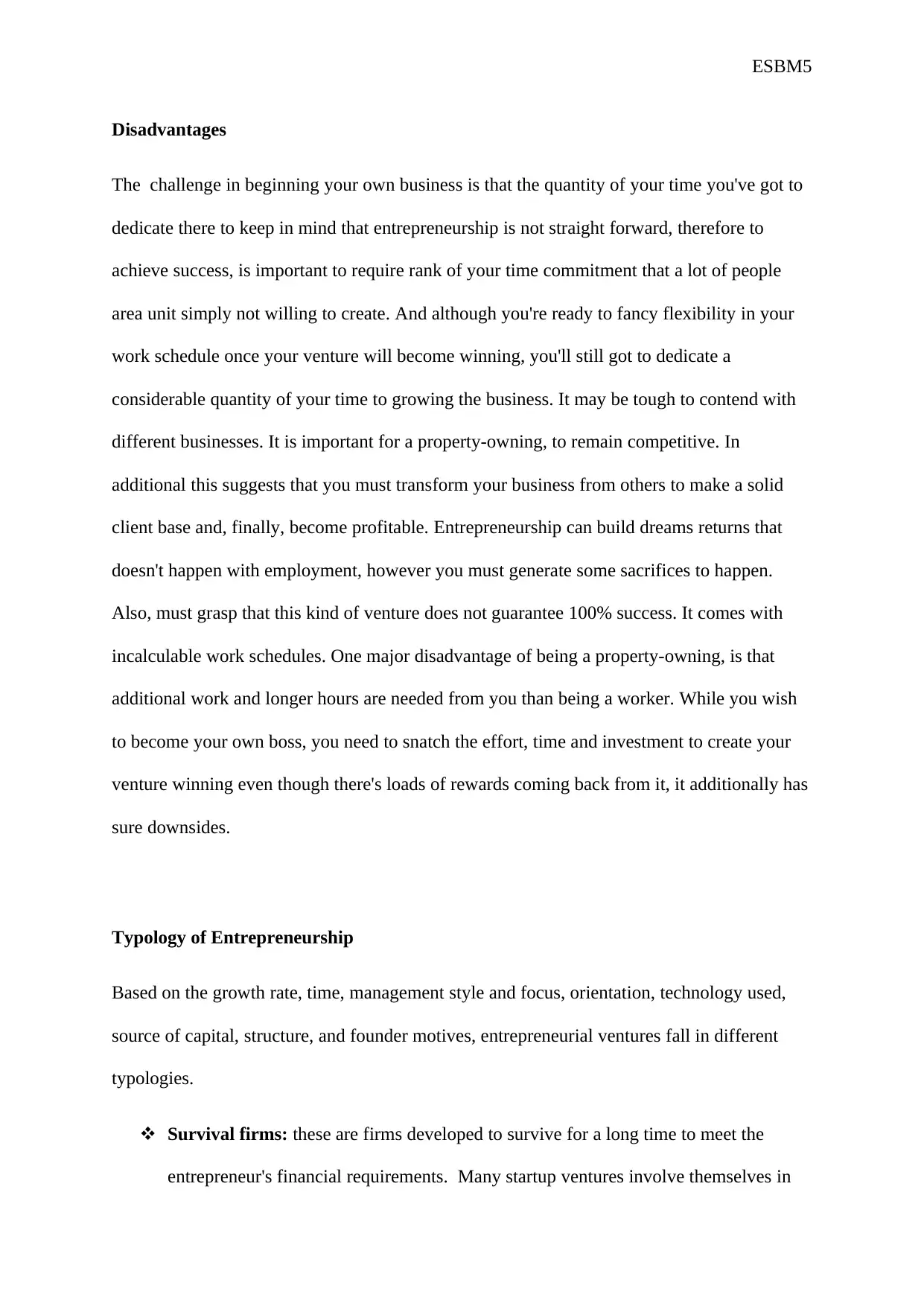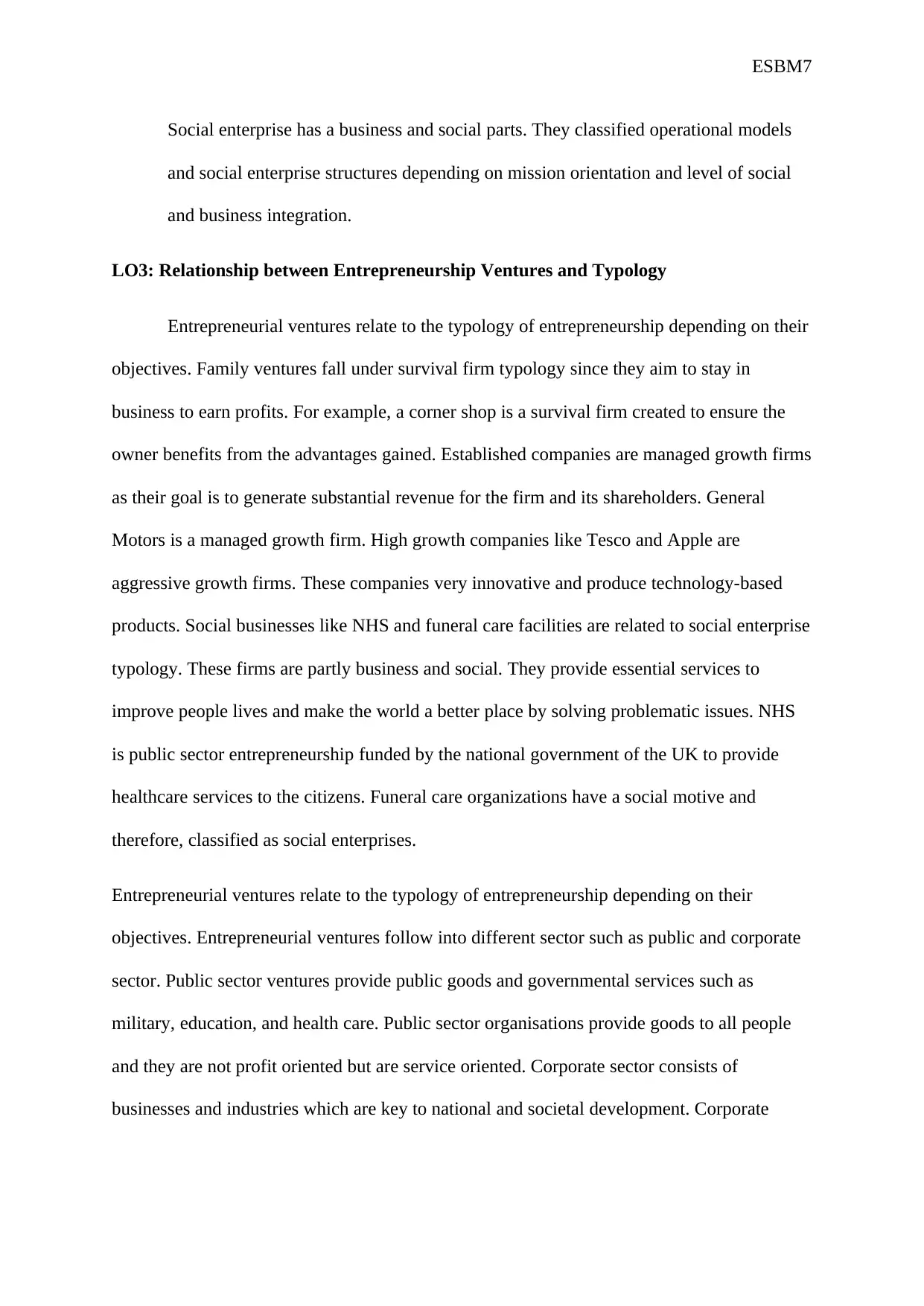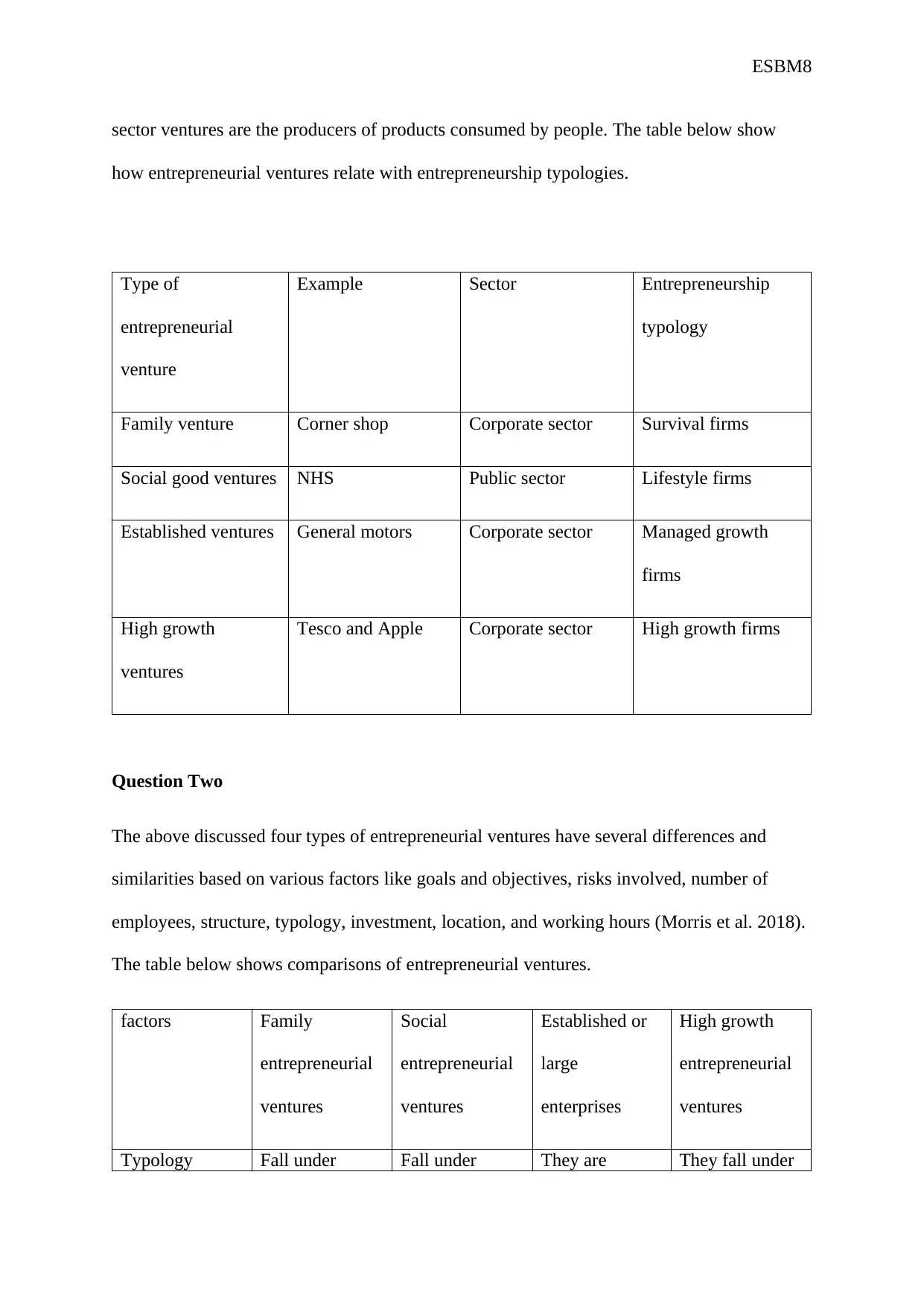ESBM18 - Entrepreneurship and Small Business Management Report
VerifiedAdded on 2022/10/18
|18
|4066
|13
Report
AI Summary
This report provides a detailed analysis of entrepreneurship and small business management, covering various aspects such as entrepreneurial ventures, advantages and disadvantages of entrepreneurship, and typologies of entrepreneurship based on growth rate, time, and management style. It discusses different types of entrepreneurial ventures including family businesses, social good enterprises, established companies, and high-growth companies, highlighting their objectives, organizational structures, and associated risks. The report also explores the relationship between entrepreneurial ventures and typologies, illustrating how different ventures align with survival firms, managed growth firms, aggressive growth firms, and social enterprises. Furthermore, it compares and contrasts the four types of entrepreneurial ventures based on factors like goals, risks, number of employees, structure, investment, and working hours. This comprehensive overview is ideal for students studying entrepreneurship and business management, and similar solved assignments and past papers are available on Desklib to aid further learning.

ESBM1
ASSIGNMENT SUBMISSION FORM
This sheet must be submitted with your assignment. Failure to complete, sign and
submit this form will result in a mark of ‘0’ for the assignment.
Student Name Nadia Ismael Daude Valigy
Student ID P1097714
Assessor Name Eugenia
Qualification HND In Business Management
Unit Number & Unit
Title
Entrepreneurship and Small Business Management
Assignment Title Entrepreneurship and Small Business Management
Date of Submission 27/05/2019
Signature: Nadia Ismael Daude Valigy…… Date: 27/05/2019………
ASSIGNMENT SUBMISSION FORM
This sheet must be submitted with your assignment. Failure to complete, sign and
submit this form will result in a mark of ‘0’ for the assignment.
Student Name Nadia Ismael Daude Valigy
Student ID P1097714
Assessor Name Eugenia
Qualification HND In Business Management
Unit Number & Unit
Title
Entrepreneurship and Small Business Management
Assignment Title Entrepreneurship and Small Business Management
Date of Submission 27/05/2019
Signature: Nadia Ismael Daude Valigy…… Date: 27/05/2019………
Paraphrase This Document
Need a fresh take? Get an instant paraphrase of this document with our AI Paraphraser

ESBM2
LO1: Introduction
Entrepreneurship refers to the process of starting a business with the aim of making
profits. An entrepreneur is a person who starts a company to make profits. Entrepreneurs
come up with ideas and execute them through the process of entrepreneurship. Entrepreneurs
are significant as they focus on ensuring that the world progresses through the creation of job
opportunities, change production, give to society and contributes to the national revenue. As
entrepreneur’s business grows, jobs are created hence reducing unemployment rates in the
country. Entrepreneurs create change by, for example exploring new things and developing
new products.
Entrepreneurs give to society through the payment of taxes, give donations, and invest
in poor communities. Entrepreneurs add to national income through the creation of products,
development of new markets, and wealth in an economy. It is essential to study
entrepreneurship unit as one gains several skills such as creativity, management, and
employment in well-paying jobs like franchise operator. The world is changing, and it is hard
to secure a job; thus, entrepreneurship is a vital unit as it helps students come up with ideas,
start a new business and earn profits at the end. This unit allows people to employ themselves
rather than waiting to be hired (Burns, 2016).
LO1: Introduction
Entrepreneurship refers to the process of starting a business with the aim of making
profits. An entrepreneur is a person who starts a company to make profits. Entrepreneurs
come up with ideas and execute them through the process of entrepreneurship. Entrepreneurs
are significant as they focus on ensuring that the world progresses through the creation of job
opportunities, change production, give to society and contributes to the national revenue. As
entrepreneur’s business grows, jobs are created hence reducing unemployment rates in the
country. Entrepreneurs create change by, for example exploring new things and developing
new products.
Entrepreneurs give to society through the payment of taxes, give donations, and invest
in poor communities. Entrepreneurs add to national income through the creation of products,
development of new markets, and wealth in an economy. It is essential to study
entrepreneurship unit as one gains several skills such as creativity, management, and
employment in well-paying jobs like franchise operator. The world is changing, and it is hard
to secure a job; thus, entrepreneurship is a vital unit as it helps students come up with ideas,
start a new business and earn profits at the end. This unit allows people to employ themselves
rather than waiting to be hired (Burns, 2016).

ESBM3
Types of Entrepreneurial Ventures
With the skills and knowledge gained from this unit, people can come up with
different entrepreneurial ventures which differ in size, potential, and vision. Entrepreneurs'
start-up businesses with different aims like growth, innovation, and profitability. Different
goals result in various types of entrepreneurial ventures such as family businesses ventures,
good social ventures, established or large business ventures, and high growth companies.
Family businesses comprise of small companies, independently owned to raise profits and
income to support a family. Family firms are created and developed to generate the revenue
required to provide basic need to the family such as food, shelter, clothing, and education.
Family ventures may sometimes grow or not grow depending on the innovativeness of the
entrepreneur. Many family ventures which are only managed by family members may not,
but those who hire external employees eventually grow. Family ventures consist of different
kind of business-like restaurants, agriculture, retail stores, and construction firms. Family
ventures primary source of capital is personal funds, family, or friends but can also borrow
from banks.
Social good enterprises are an entrepreneurial venture created and developed to
provide innovative solutions to bring change in the world. Social enterprise includes
companies with a specific goal like solve health issues and non-profits companies with a
charitable mission. Social ventures are not profit oriented and therefore, provide social
benefits and improve people's lives. Established companies are large businesses created to
generate revenue for the company and the shareholders. Established businesses are very
significant in employment creation as they employ over five hundred people. The capital
required to start large ventures come from revenue gained, tax credits, or subsidiaries.
Examples of established businesses are corporations like General Motors.
Types of Entrepreneurial Ventures
With the skills and knowledge gained from this unit, people can come up with
different entrepreneurial ventures which differ in size, potential, and vision. Entrepreneurs'
start-up businesses with different aims like growth, innovation, and profitability. Different
goals result in various types of entrepreneurial ventures such as family businesses ventures,
good social ventures, established or large business ventures, and high growth companies.
Family businesses comprise of small companies, independently owned to raise profits and
income to support a family. Family firms are created and developed to generate the revenue
required to provide basic need to the family such as food, shelter, clothing, and education.
Family ventures may sometimes grow or not grow depending on the innovativeness of the
entrepreneur. Many family ventures which are only managed by family members may not,
but those who hire external employees eventually grow. Family ventures consist of different
kind of business-like restaurants, agriculture, retail stores, and construction firms. Family
ventures primary source of capital is personal funds, family, or friends but can also borrow
from banks.
Social good enterprises are an entrepreneurial venture created and developed to
provide innovative solutions to bring change in the world. Social enterprise includes
companies with a specific goal like solve health issues and non-profits companies with a
charitable mission. Social ventures are not profit oriented and therefore, provide social
benefits and improve people's lives. Established companies are large businesses created to
generate revenue for the company and the shareholders. Established businesses are very
significant in employment creation as they employ over five hundred people. The capital
required to start large ventures come from revenue gained, tax credits, or subsidiaries.
Examples of established businesses are corporations like General Motors.
⊘ This is a preview!⊘
Do you want full access?
Subscribe today to unlock all pages.

Trusted by 1+ million students worldwide

ESBM4
High growth companies are scalable start-ups, whose main objective is the generation
of wealth to the founders and investors. Scalable entrepreneurs start their business with a
vision of changing the world in the future. High-tech firms can, through the use of
technology-based products and services, develop new markets, or replace the existing ones.
Scalable entrepreneurs are risk takers and innovative. High growth enterprises are significant
because they create more jobs, generate profits and economic impacts (Morris et al. 2018).
Advantages
If you are operating a corporation, then would like to fulfil all their necessities and solely
have little or no freedom on the duty. On the opposite site, if you begin your own business,
you'll be able to generate your own demands and set your own schedule. You dictate
everything you are doing, providing you with a level of freedom that you simply won't see
once your area unit utilized.
Entrepreneurship would be exciting, with several entrepreneurs considering their ventures
extremely enjoyable. New opportunities to challenge your determination, skills and talents.
Also, the owner is the one setting their own wage and creating investments after you own the
business. The work that you simply do would be for one thing you own, which might be a
large advantage compared to after your area unit operating as Associate in nursing worker for
a company. As Associate in nursing businessperson, you'll be able to schedule your work
hours around alternative commitments, together with quality time you'd pay together with
your family.
High growth companies are scalable start-ups, whose main objective is the generation
of wealth to the founders and investors. Scalable entrepreneurs start their business with a
vision of changing the world in the future. High-tech firms can, through the use of
technology-based products and services, develop new markets, or replace the existing ones.
Scalable entrepreneurs are risk takers and innovative. High growth enterprises are significant
because they create more jobs, generate profits and economic impacts (Morris et al. 2018).
Advantages
If you are operating a corporation, then would like to fulfil all their necessities and solely
have little or no freedom on the duty. On the opposite site, if you begin your own business,
you'll be able to generate your own demands and set your own schedule. You dictate
everything you are doing, providing you with a level of freedom that you simply won't see
once your area unit utilized.
Entrepreneurship would be exciting, with several entrepreneurs considering their ventures
extremely enjoyable. New opportunities to challenge your determination, skills and talents.
Also, the owner is the one setting their own wage and creating investments after you own the
business. The work that you simply do would be for one thing you own, which might be a
large advantage compared to after your area unit operating as Associate in nursing worker for
a company. As Associate in nursing businessperson, you'll be able to schedule your work
hours around alternative commitments, together with quality time you'd pay together with
your family.
Paraphrase This Document
Need a fresh take? Get an instant paraphrase of this document with our AI Paraphraser

ESBM5
Disadvantages
The challenge in beginning your own business is that the quantity of your time you've got to
dedicate there to keep in mind that entrepreneurship is not straight forward, therefore to
achieve success, is important to require rank of your time commitment that a lot of people
area unit simply not willing to create. And although you're ready to fancy flexibility in your
work schedule once your venture will become winning, you'll still got to dedicate a
considerable quantity of your time to growing the business. It may be tough to contend with
different businesses. It is important for a property-owning, to remain competitive. In
additional this suggests that you must transform your business from others to make a solid
client base and, finally, become profitable. Entrepreneurship can build dreams returns that
doesn't happen with employment, however you must generate some sacrifices to happen.
Also, must grasp that this kind of venture does not guarantee 100% success. It comes with
incalculable work schedules. One major disadvantage of being a property-owning, is that
additional work and longer hours are needed from you than being a worker. While you wish
to become your own boss, you need to snatch the effort, time and investment to create your
venture winning even though there's loads of rewards coming back from it, it additionally has
sure downsides.
Typology of Entrepreneurship
Based on the growth rate, time, management style and focus, orientation, technology used,
source of capital, structure, and founder motives, entrepreneurial ventures fall in different
typologies.
Survival firms: these are firms developed to survive for a long time to meet the
entrepreneur's financial requirements. Many startup ventures involve themselves in
Disadvantages
The challenge in beginning your own business is that the quantity of your time you've got to
dedicate there to keep in mind that entrepreneurship is not straight forward, therefore to
achieve success, is important to require rank of your time commitment that a lot of people
area unit simply not willing to create. And although you're ready to fancy flexibility in your
work schedule once your venture will become winning, you'll still got to dedicate a
considerable quantity of your time to growing the business. It may be tough to contend with
different businesses. It is important for a property-owning, to remain competitive. In
additional this suggests that you must transform your business from others to make a solid
client base and, finally, become profitable. Entrepreneurship can build dreams returns that
doesn't happen with employment, however you must generate some sacrifices to happen.
Also, must grasp that this kind of venture does not guarantee 100% success. It comes with
incalculable work schedules. One major disadvantage of being a property-owning, is that
additional work and longer hours are needed from you than being a worker. While you wish
to become your own boss, you need to snatch the effort, time and investment to create your
venture winning even though there's loads of rewards coming back from it, it additionally has
sure downsides.
Typology of Entrepreneurship
Based on the growth rate, time, management style and focus, orientation, technology used,
source of capital, structure, and founder motives, entrepreneurial ventures fall in different
typologies.
Survival firms: these are firms developed to survive for a long time to meet the
entrepreneur's financial requirements. Many startup ventures involve themselves in

ESBM6
survival firms to stay in business for a particular duration. Low costs characterize
these firms, employees lay off, employment reduction, fear of future commitments,
and management focus on present dealings.
Lifestyle firms: these are firms which are created to perform activities that the owner
adores and also to raise enough revenue for the owner. Small sized business is
lifestyle firms as they are developed to meet the owner's objectives. Characteristics of
lifestyle firms are irrational management activities, long working hours, high risks of
failure, low profits, underutilization of resources, and limited growth rate.
Managed growth firms: these are firms which only pursues a stable growth rate over
a specific time. Ventures under this typology have characteristics like the occasional
launch of new products, steady facility, location and workforce expansion, strong
local and regional brand and sporadic entrance into new markets.
Aggressive growth firms: these are firms which are technology-based and are very
innovative. They mainly seek for exponential growth. Dynamic growth firm's
characteristics are a substantial initial investment, competent human resource, cash
flow, and expanding operations. Opportunities drive these firms to create and enter
new markets, whether national or international.
Public sector entrepreneurship: public sector entrepreneurship refers to innovative
processes carried out in the public sector organizations. Public sector entrepreneurship
includes all activities taken by local, regional, and national authorities to support
startup entrepreneurs. Public sector entrepreneurship characteristics are the
development of new and existing products, diversity networks, technology, and
innovativeness.
Social enterprise: social enterprise typology eliminates traditional boundaries
between nonprofit firms and private sector through the creation of a social enterprise.
survival firms to stay in business for a particular duration. Low costs characterize
these firms, employees lay off, employment reduction, fear of future commitments,
and management focus on present dealings.
Lifestyle firms: these are firms which are created to perform activities that the owner
adores and also to raise enough revenue for the owner. Small sized business is
lifestyle firms as they are developed to meet the owner's objectives. Characteristics of
lifestyle firms are irrational management activities, long working hours, high risks of
failure, low profits, underutilization of resources, and limited growth rate.
Managed growth firms: these are firms which only pursues a stable growth rate over
a specific time. Ventures under this typology have characteristics like the occasional
launch of new products, steady facility, location and workforce expansion, strong
local and regional brand and sporadic entrance into new markets.
Aggressive growth firms: these are firms which are technology-based and are very
innovative. They mainly seek for exponential growth. Dynamic growth firm's
characteristics are a substantial initial investment, competent human resource, cash
flow, and expanding operations. Opportunities drive these firms to create and enter
new markets, whether national or international.
Public sector entrepreneurship: public sector entrepreneurship refers to innovative
processes carried out in the public sector organizations. Public sector entrepreneurship
includes all activities taken by local, regional, and national authorities to support
startup entrepreneurs. Public sector entrepreneurship characteristics are the
development of new and existing products, diversity networks, technology, and
innovativeness.
Social enterprise: social enterprise typology eliminates traditional boundaries
between nonprofit firms and private sector through the creation of a social enterprise.
⊘ This is a preview!⊘
Do you want full access?
Subscribe today to unlock all pages.

Trusted by 1+ million students worldwide

ESBM7
Social enterprise has a business and social parts. They classified operational models
and social enterprise structures depending on mission orientation and level of social
and business integration.
LO3: Relationship between Entrepreneurship Ventures and Typology
Entrepreneurial ventures relate to the typology of entrepreneurship depending on their
objectives. Family ventures fall under survival firm typology since they aim to stay in
business to earn profits. For example, a corner shop is a survival firm created to ensure the
owner benefits from the advantages gained. Established companies are managed growth firms
as their goal is to generate substantial revenue for the firm and its shareholders. General
Motors is a managed growth firm. High growth companies like Tesco and Apple are
aggressive growth firms. These companies very innovative and produce technology-based
products. Social businesses like NHS and funeral care facilities are related to social enterprise
typology. These firms are partly business and social. They provide essential services to
improve people lives and make the world a better place by solving problematic issues. NHS
is public sector entrepreneurship funded by the national government of the UK to provide
healthcare services to the citizens. Funeral care organizations have a social motive and
therefore, classified as social enterprises.
Entrepreneurial ventures relate to the typology of entrepreneurship depending on their
objectives. Entrepreneurial ventures follow into different sector such as public and corporate
sector. Public sector ventures provide public goods and governmental services such as
military, education, and health care. Public sector organisations provide goods to all people
and they are not profit oriented but are service oriented. Corporate sector consists of
businesses and industries which are key to national and societal development. Corporate
Social enterprise has a business and social parts. They classified operational models
and social enterprise structures depending on mission orientation and level of social
and business integration.
LO3: Relationship between Entrepreneurship Ventures and Typology
Entrepreneurial ventures relate to the typology of entrepreneurship depending on their
objectives. Family ventures fall under survival firm typology since they aim to stay in
business to earn profits. For example, a corner shop is a survival firm created to ensure the
owner benefits from the advantages gained. Established companies are managed growth firms
as their goal is to generate substantial revenue for the firm and its shareholders. General
Motors is a managed growth firm. High growth companies like Tesco and Apple are
aggressive growth firms. These companies very innovative and produce technology-based
products. Social businesses like NHS and funeral care facilities are related to social enterprise
typology. These firms are partly business and social. They provide essential services to
improve people lives and make the world a better place by solving problematic issues. NHS
is public sector entrepreneurship funded by the national government of the UK to provide
healthcare services to the citizens. Funeral care organizations have a social motive and
therefore, classified as social enterprises.
Entrepreneurial ventures relate to the typology of entrepreneurship depending on their
objectives. Entrepreneurial ventures follow into different sector such as public and corporate
sector. Public sector ventures provide public goods and governmental services such as
military, education, and health care. Public sector organisations provide goods to all people
and they are not profit oriented but are service oriented. Corporate sector consists of
businesses and industries which are key to national and societal development. Corporate
Paraphrase This Document
Need a fresh take? Get an instant paraphrase of this document with our AI Paraphraser

ESBM8
sector ventures are the producers of products consumed by people. The table below show
how entrepreneurial ventures relate with entrepreneurship typologies.
Type of
entrepreneurial
venture
Example Sector Entrepreneurship
typology
Family venture Corner shop Corporate sector Survival firms
Social good ventures NHS Public sector Lifestyle firms
Established ventures General motors Corporate sector Managed growth
firms
High growth
ventures
Tesco and Apple Corporate sector High growth firms
Question Two
The above discussed four types of entrepreneurial ventures have several differences and
similarities based on various factors like goals and objectives, risks involved, number of
employees, structure, typology, investment, location, and working hours (Morris et al. 2018).
The table below shows comparisons of entrepreneurial ventures.
factors Family
entrepreneurial
ventures
Social
entrepreneurial
ventures
Established or
large
enterprises
High growth
entrepreneurial
ventures
Typology Fall under Fall under They are They fall under
sector ventures are the producers of products consumed by people. The table below show
how entrepreneurial ventures relate with entrepreneurship typologies.
Type of
entrepreneurial
venture
Example Sector Entrepreneurship
typology
Family venture Corner shop Corporate sector Survival firms
Social good ventures NHS Public sector Lifestyle firms
Established ventures General motors Corporate sector Managed growth
firms
High growth
ventures
Tesco and Apple Corporate sector High growth firms
Question Two
The above discussed four types of entrepreneurial ventures have several differences and
similarities based on various factors like goals and objectives, risks involved, number of
employees, structure, typology, investment, location, and working hours (Morris et al. 2018).
The table below shows comparisons of entrepreneurial ventures.
factors Family
entrepreneurial
ventures
Social
entrepreneurial
ventures
Established or
large
enterprises
High growth
entrepreneurial
ventures
Typology Fall under Fall under They are They fall under

ESBM9
survival and
lifestyle firm’s
typology as they
are developed to
perform
activities liked
by the owner
and have to
survive for a
long time to
meet the
owner's goals.
social enterprise
typology
managed
growth firms
aggressive
growth firms
Goals and
objectives
These firms
goal may not be
structured as
they are formed
to produce
profits, which
enables the
owner to
acquire basic
needs for the
family. They
don't focus on
achieving
These
organizations
main objective
is to make the
world a better
place to live in
by providing
quality products
and services to
people such as
health care
services.
These
organizations
main objective
is to generate
revenue for its
shareholders
and company
through the
development of
new products
and markets.
These
organizations
main objective
is to generate
revenue for the
investors and
founders by
constantly
proving
innovative
products.
survival and
lifestyle firm’s
typology as they
are developed to
perform
activities liked
by the owner
and have to
survive for a
long time to
meet the
owner's goals.
social enterprise
typology
managed
growth firms
aggressive
growth firms
Goals and
objectives
These firms
goal may not be
structured as
they are formed
to produce
profits, which
enables the
owner to
acquire basic
needs for the
family. They
don't focus on
achieving
These
organizations
main objective
is to make the
world a better
place to live in
by providing
quality products
and services to
people such as
health care
services.
These
organizations
main objective
is to generate
revenue for its
shareholders
and company
through the
development of
new products
and markets.
These
organizations
main objective
is to generate
revenue for the
investors and
founders by
constantly
proving
innovative
products.
⊘ This is a preview!⊘
Do you want full access?
Subscribe today to unlock all pages.

Trusted by 1+ million students worldwide

ESBM10
growth
Organizational
structure
There is no
proper
organizational
structure, and
the business
takes the form
of sole
proprietorship
and sometimes
partnership
among family
members.
The
organizational
structure is
mainly that of
trustee based
organizations.
The
organizational
structure is
mainly
corporations
and sometimes
partnerships.
Have a complex
organizational
structure like
that of a private
and public
company.
growth
Organizational
structure
There is no
proper
organizational
structure, and
the business
takes the form
of sole
proprietorship
and sometimes
partnership
among family
members.
The
organizational
structure is
mainly that of
trustee based
organizations.
The
organizational
structure is
mainly
corporations
and sometimes
partnerships.
Have a complex
organizational
structure like
that of a private
and public
company.
Paraphrase This Document
Need a fresh take? Get an instant paraphrase of this document with our AI Paraphraser

ESBM11
Risks involved Low risks
involved to start
and run the
business but
competition is
high because of
the existence of
similar firms.
The
organizations
gain support
from the
government;
thus, the risks
involved are not
very high.
They develop
new products
and marketing
strategies; thus,
the risks
encountered are
medium
because they
manage to sell a
large volume of
the products
produced.
The risks are
very high as it
constitutes
substantial
financial
investments and
a lot of pressure
from investors
to meet their
return
expectation.
Employee
number
These
organizations
have not more
than fifty
employees
The number of
employees
depends on the
size of the
company
These
organizations
are large
businesses and
employee over
five hundred
employees
(Storey, 2016).
Depends on the
size and
organizational
structure
Working hours No set working
hours and can
work for long
hours
Work extra
hours for some
benefits but not
money
Strictly
followed
working
schedules but in
Work extra
hours for
financial
Risks involved Low risks
involved to start
and run the
business but
competition is
high because of
the existence of
similar firms.
The
organizations
gain support
from the
government;
thus, the risks
involved are not
very high.
They develop
new products
and marketing
strategies; thus,
the risks
encountered are
medium
because they
manage to sell a
large volume of
the products
produced.
The risks are
very high as it
constitutes
substantial
financial
investments and
a lot of pressure
from investors
to meet their
return
expectation.
Employee
number
These
organizations
have not more
than fifty
employees
The number of
employees
depends on the
size of the
company
These
organizations
are large
businesses and
employee over
five hundred
employees
(Storey, 2016).
Depends on the
size and
organizational
structure
Working hours No set working
hours and can
work for long
hours
Work extra
hours for some
benefits but not
money
Strictly
followed
working
schedules but in
Work extra
hours for
financial

ESBM12
case of extra
hours, gain
compensation
in terms of
money.
benefits
Capital sources Owner personal
savings
Funded by
government
Shareholders
and company
revenue
Investors
Question Three
Different data and statistics have shown that small and medium-sized businesses refer to any
business with less than two hundred and fifty employees. Microenterprises are all businesses
which have 0-9 employees. In all countries, micro and small businesses are very many and
have a considerable contribution to the economy. Statistics have shown that in every one
hundred enterprises in the UK, nighty nine are micro and small businesses because they have
less than two hundred and fifty employees. Revenue contributed by micro, and small business
enterprises promote UK gross domestic product (GDP). Micro and small businesses have
various impacts on the UK economy such as job creation, unemployment creation, promoting
GDP or value, diversification, linkages and foreign trade, and inflation reduction (Burns,
2016). Research and statistics have shown micro, and small businesses create a large
percentage of new jobs in the UK. Though the employee fewer than 250 employees they are
very many, thus creating a lot of job opportunities. These firms employ less-skilled and
workers with no work experience. These employment practices are very significant to the
case of extra
hours, gain
compensation
in terms of
money.
benefits
Capital sources Owner personal
savings
Funded by
government
Shareholders
and company
revenue
Investors
Question Three
Different data and statistics have shown that small and medium-sized businesses refer to any
business with less than two hundred and fifty employees. Microenterprises are all businesses
which have 0-9 employees. In all countries, micro and small businesses are very many and
have a considerable contribution to the economy. Statistics have shown that in every one
hundred enterprises in the UK, nighty nine are micro and small businesses because they have
less than two hundred and fifty employees. Revenue contributed by micro, and small business
enterprises promote UK gross domestic product (GDP). Micro and small businesses have
various impacts on the UK economy such as job creation, unemployment creation, promoting
GDP or value, diversification, linkages and foreign trade, and inflation reduction (Burns,
2016). Research and statistics have shown micro, and small businesses create a large
percentage of new jobs in the UK. Though the employee fewer than 250 employees they are
very many, thus creating a lot of job opportunities. These firms employ less-skilled and
workers with no work experience. These employment practices are very significant to the
⊘ This is a preview!⊘
Do you want full access?
Subscribe today to unlock all pages.

Trusted by 1+ million students worldwide
1 out of 18
Related Documents
Your All-in-One AI-Powered Toolkit for Academic Success.
+13062052269
info@desklib.com
Available 24*7 on WhatsApp / Email
![[object Object]](/_next/static/media/star-bottom.7253800d.svg)
Unlock your academic potential
Copyright © 2020–2025 A2Z Services. All Rights Reserved. Developed and managed by ZUCOL.





